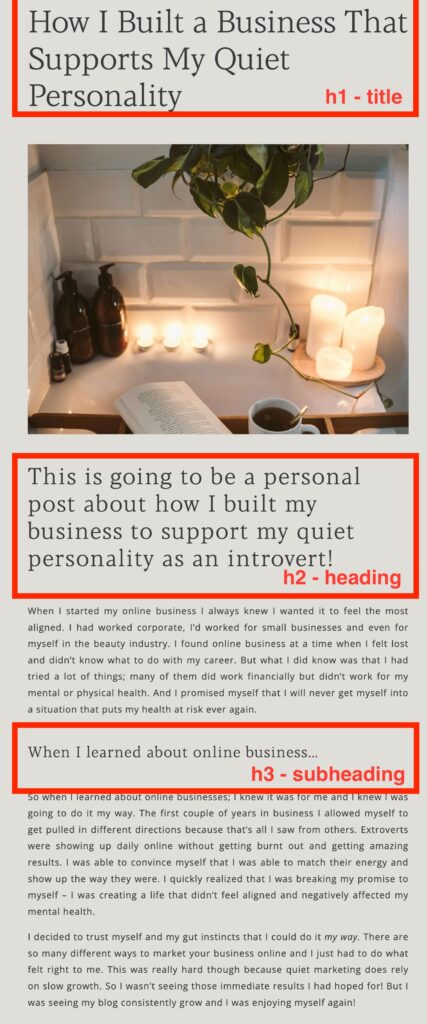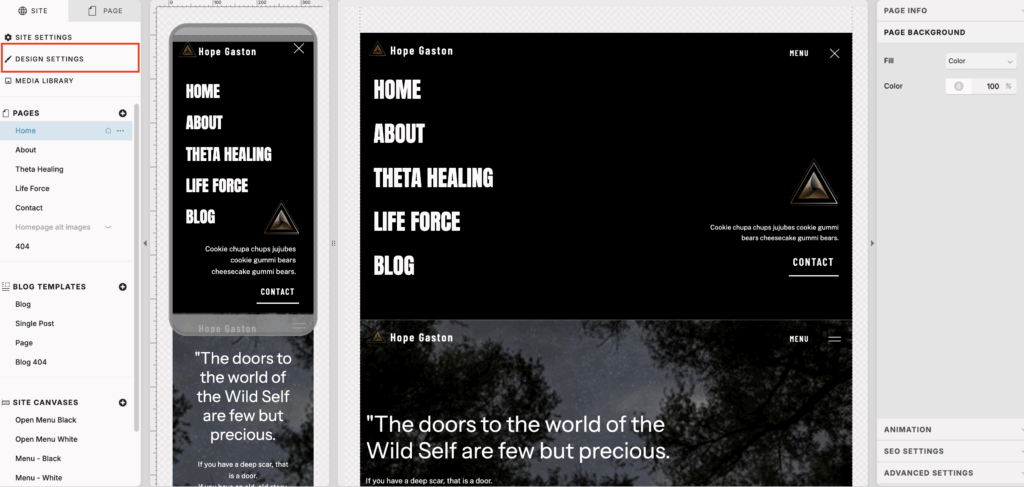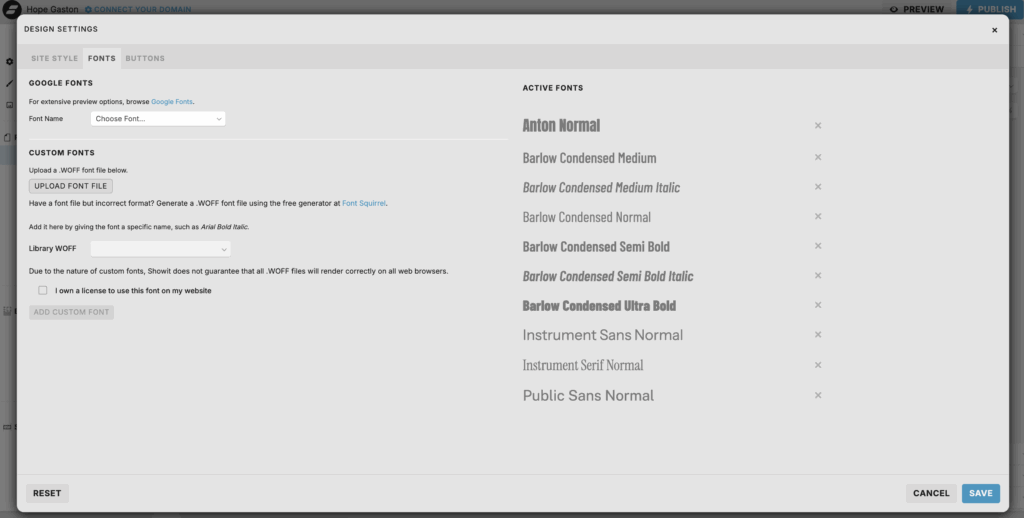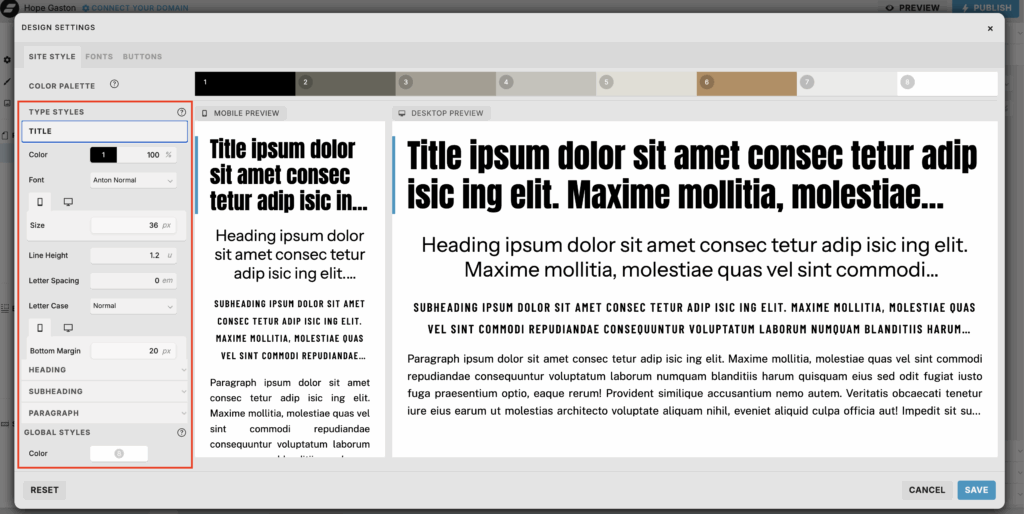In this post you will learn how to use SEO header tags to make your Showit website easier to read for both visitors and search engines!
In order for you to clearly understand seo headers, we will discuss the following:
- What are header tags (h1, h2, h3, etc.)
- What is the purpose of heading tags and why they are important for SEO and user experience
- What is the role of each heading tag
- How to correctly set up SEO headings on Showit
- Common mistakes to avoid when optimizing your heading tag in html
- Tips on writing SEO friendly headings
If you feel even slightly overwhelmed by reading that list; don’t worry! I promise, it’s much less complicated than it might seem. It’s so easy to correctly set up your SEO heading tags and the best part? You do not need to use any code! You can do it directly within Showits’ native settings, basically with a click (or a couple of clicks!).
And to quickly squash any thoughts you might have of “do I really need to use heading tags on my website?” – yes, you do! It’s a really simple and easy way to add a little more SEO juice to your website!
By the end of this post you will know exactly how to structure your website copy so it’s super clear for readers and Search Engines to understand!
**TL;DR – How to Use Header Tags for SEO in Showit:**
- SEO header tags should correctly be applied to each text box on your web page so Google can understand the content. They’re also helpful for your website visitors because they can skim the content and easily find what they’re looking for.
- Only use one h1 tag per page; this will be the main title of that specific web page
- Use h2 headers to introduce topics and h3 headers as subheadings nestled within h2 headers.
- Apply your HTML header tags on Showit through your Design Settings or manually using the text properties tab.
You know you need a website for your business but you have no idea where to start?
Don’t worry, I got you!
Sign up below to download your FREE Website Content Roadmap to get started!
What are header tags (h1, h2, h3, etc.)
“Header tags, also known as heading tags, are used to separate headings and subheadings on a webpage. They rank in order of importance, from H1 to H6, with H1s usually being the title. Header tags improve the readability and SEO of a webpage.” – Hubspot
*Even though there are up to 6 heading tags (from h1 to h6), we only have 3 heading options within Showit itself. However, you can apply more heading tags within WordPress for your blog posts.
What is the purpose of heading tags and why they are important for SEO and user experience
Header tags are used to determine the content hierarchy of your website or blog copy (the writing on the page). Think back to when you were in school and taking notes in class. You would have your title for the topic you were taking notes on. From there you would have headings and subheadings so it would be easy for you to skim and find what you’re looking for when you went back to read your notes.
Headings and subheadings make your copy skimmable so it’s easier to read. Most people these days are not sitting there and reading every word on your page. They are skimming your content so they can easily find what they are looking for. This is why using SEO header tags is so important. It makes your user experience better by making your content easy to read.
Another reason header tags are so important is because they make your content easier for search engines to understand. Search engines will crawl your web page; basically scan all of the content on each page. From there they index each page on your website; this is filing it so that it can retrieve your content and serve it to users when their search query matches your content
What are h1 tags?
Search engines use headers to understand the content on each page of your website. Your h1 tag is the title of that page. It will have the highest SEO importance when it comes to the copy on your page. It’s also what will tell a user what information they can expect to find on each page. Be sure to use your target SEO keywords in your h1 header! It will help you optimize that specific page for those keywords.
What is the role of each heading tag on Showit
- H1 – Heading 1; this is used for your page title. This should only be used once per page and should include our main target keywords.
- H2 – Heading 2; used for headings to break up each section. Use these headers to organize your main topics on each page.
- H3: heading 3; These are used for subheadings that are nested within your h2 header. Use these to further break down the topics. These help with SEO and with readability as they help make your content skimmable.
- Add related keywords to as many headers as possible as they hold SEO weight! They tell search engines what content is found in that specific section on your page. But be sure not to over use keywords and make sure they actually make sense where you’re using them.
Here’s an example of heading tags on one of my previous blog posts:

How to correctly set up SEO headings on Showit
Showit makes it so easy to apply HTML heading tags to your website copy!
Here are the exact steps to follow:
- Select the copy you want to apply your heading tag to
- Select the text properties tab on the right hand side menu
- Select the drop down next to text tag
- Select the type of heading you want to apply (h1, h2, h3, etc.)
Et voila, your html heading text tag is now correctly applied to your copy! Be sure to follow the guidelines I shared earlier in this post (under “what is the role of each heading tag on Showit”) so you know what tag to apply where!

I also want to show you how you can apply your header style settings on Showit.
When you apply style settings within Showit, it allows you to use the same font style throughout your website. You set it once within Design Settings and use the styles you’ve already set or you can modify it for specific text boxes if you’d like.
Here is how you apply your header font settings on Showit:
- Select Design Settings on the left hand side
- Select the Font tab and add your Google Fonts or upload custom fonts here. Be sure to hit save!
- Select the Site Style tab. Here you can set your title, heading, subheading and paragraph fonts.
Showit will automatically apply SEO header tags to these font styles.
- When you add a title text box it will automatically be set as h1
- Headings will be set as h2
- Subheadings are set as h3
But you can manually change these the way I showed you above!



Common mistakes to avoid when optimizing your heading tag in html
- Don’t just style your font to appear as a title or heading without actually applying your SEO heading tags.
- Do not use more than one h1 on your web page. Each page on your website can only have one title.
- Add SEO keywords where they make sense! Do not keyword stuff, aka add a bunch of keywords for the sake of adding them. It’s more important that your content makes sense to humans than just optimizing for SEO.
- Do not skip adding headers to your copy! People sometimes avoid them because they’re focusing on design, not structure. But overtime you will see that a clear website with structure is more important to actually appear in search results and for user experience.
Tips on writing SEO friendly headings
- Keep your headings clear and to the point. Think about a user skimming your content; you want to quickly capture their attention and make it easy for them to find what they’re looking for.
- Use related keywords in your headings. Use your target keywords in your title (you can also use it throughout your content where it makes sense), add related keywords to your headings where they can naturally fit in.
- Your headings should have a natural progression. It’s like guiding your reader through your copy.
- Think of each header as potential to answer a unique search query. A specific header can provide valuable information within a post. For example, I have a header within this very blog post: What is the role of each heading tag on Showit. This one header can answer this question for a user even if they don’t want to learn how to actually add header tags themselves. They might just be searching to find out what the purpose of a header tag is.
Conclusion: Simplicity over complicating!
I know it’s easy to get caught up in focusing on your website design. But in the long-run the structure of your website is going to out perform design. Having a clear structure for your website copy is going to help get your content found in search results. It’s going to build trust with your community because you’re helping users easily find what they’re looking for.
Use the tips I shared in this post to structure your main website pages and your blog posts! The more blog posts you write the easier it’s going to get. You will start thinking about your headings as you write your posts, it will become second nature.
Want help launching a website that has these SEO strategies built in?
Book a Website VIP Design Day where I design and launch your website in one day! (and yes, I implement all of my SEO best practices for you too!).
FAQ about applying SEO header tags on Showit website
What are SEO header tags and why are they important?
SEO header tags are used to separate your title, heading and subheadings on your web page. They help break up the text on each page to make it easier for search engines to understand. Header tags make your content skimmable so your readers can easily find the content they are looking for.
How do I add H1, H2, and H3 tags in Showit?
You can add your header tags through the text properties tag on the right hand side when you have a text box selected.
Can I use more than one H1 tag on my Showit page?
No, you should only use one h1 tag on each page of your website.
What is the correct header tag structure for SEO?
You should have one h1 tag at the top of your page, above the fold. Then you should have an h2 header tag for each topic and h3 header tags should be used as subheadings nestled within h2 tags.
How do header tags improve my website’s Google ranking?
Correctly using header tags allows Google and other search engines to crawl and index your web pages. They make it easier for Google to understand the content on each page of your website.
Is it bad to skip header levels (like going from H2 to H4)?
You should not skip header levels. There shouldn’t be a need to skip over a header. You want to think about content hierarchy and apply heading tags in a way that makes sense.
Do header tags affect how my Showit website looks?
Your header tags should not affect how your website looks because you can manually change the heading tags within text properties.
What’s the difference between styling text and using header tags?
Styling text is for the appearance of what your text looks like on your web page. Header tags are used by search engines to determine the hierarchy of your copy so it can understand the content on your page.
How can I check if my header tags are set up correctly in Showit?
You can manually check by clicking on each text box and checking which tag is applied in the text properties tab on the right hand side within the Showit Design App. Or you can add the HeadingsMap Chrome extension which will show what headers are on each page.
Can I use header tags for design only, without hurting SEO?
You should apply heading tags correctly in a way that shows search engines the hierarchy of your content. However, for design purposes you can manually change heading tags to suit the design of your page. I would recommend keeping that to a minimum though because clear content is helpful for SEO.
What should I include in my H1 tag for the best SEO results?
Your main target keywords should be added to your h1 header. I recommend using long-tail keywords to target as they will be easier to rank for.
How to Create a Website Content Strategy That Works While You Sleep!
My Quarterly Blog Planning Strategy as a Business Owner
5 SEO Mistakes Most Online Business Owners Make (And How to Fix Them)
Showit SEO: How to Add SEO to Your Showit Website the Right Way
What Is Showit? And Why It’s The Perfect Website Builder for Digital Entrepreneurs
